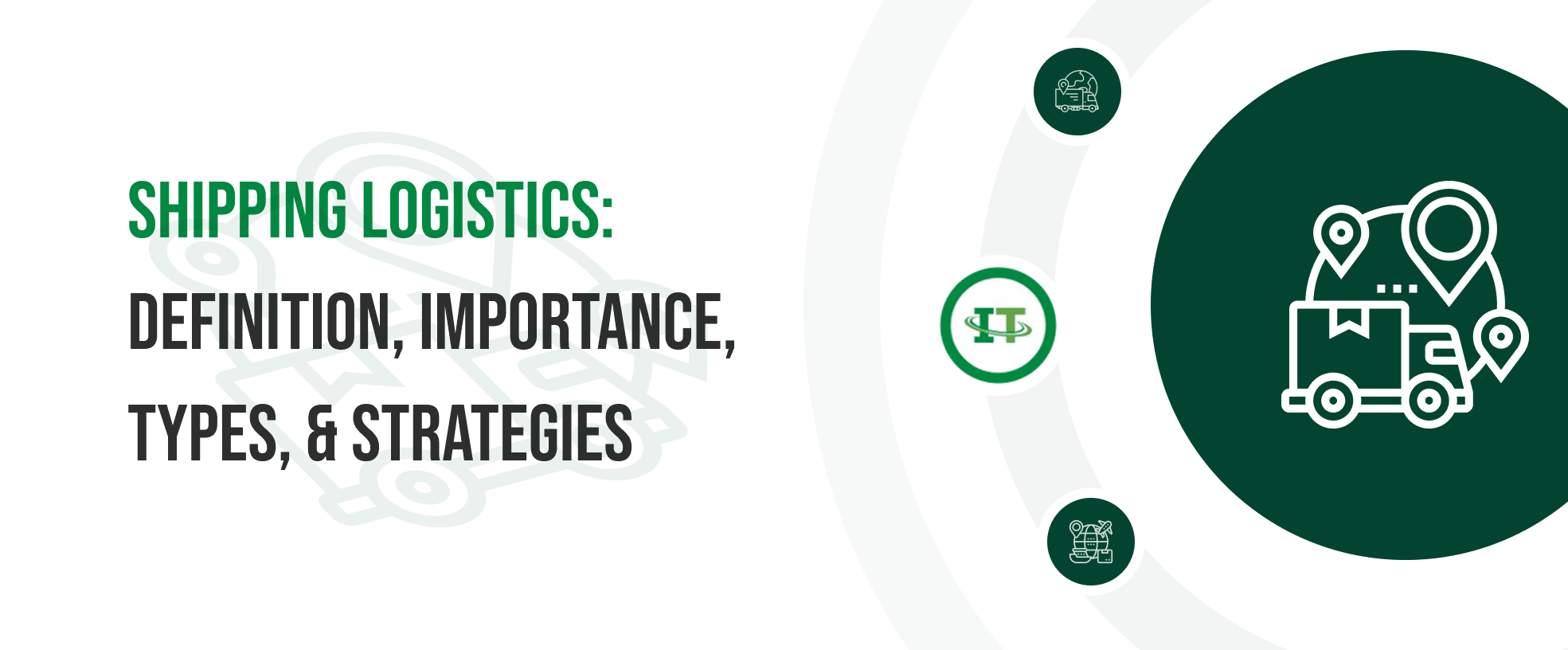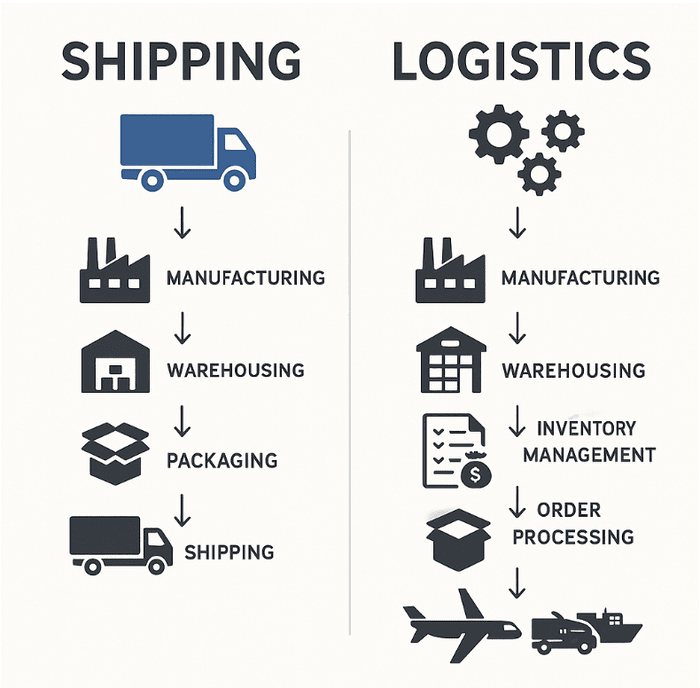What is Shipping Logistics? Definition, Types, & Strategies

Being in the logistics business requires knowing shipping, its importance, and more. Do not get lost in the jungle of lost inventory, surplus supplies, and rising fuel costs; learn what shipping logistics is.
This comprehensive guide will help you understand shipping logistics, whether you are a fleet manager, supply chain officer, customer, or warehouse operator.
What Will We Cover?
Here’s a quick look at the topics covered here:
- What’s Meant By Shipping Logistics?
- Why Does Shipping Logistics Matter?
- Shipping Vs. Logistics: What’s the Difference?
- What Are The Different Types Of Shipping Logistics?
- Best Strategies To Optimize Shipping & Logistics Operations
Let’s dive deep into shipping logistics and its various other essential aspects.
What’s Meant By Shipping Logistics?
Shipping logistics is the management of supplies from the time they enter the supply chain until they leave it. It involves several activities, such as planning, managing, coordinating, and transporting goods. It leads to efficiency and cost savings.
Logistics entails all activities, such as handling supplies, planning, controlling, storing, and moving them until they reach customers. In contrast, shipping is transporting goods via sea.
Shipping logistics involves both inbound and outbound logistics. It involves everything from choosing a carrier to planning the routes, tracking the shipments, and ensuring supplies arrive on time.
Why Does Shipping Logistics Matter?
Customers are the king, and keeping them happy with on-time deliveries is the primary purpose of logistics. Here’s why shipping logistics matter:
- On-time deliveries: There is a sharp increase in people shopping online, and many customers today require on-time delivery. With the help of real-time tracking and valuable data insights, on-time deliveries can be assured.
- Customer Satisfaction & Retention: It helps minimize delays, prevent errors, and ensure that deliveries arrive on time, building customer trust.
- Scalable Logistics Operations: Scalable logistics operations can meet companies’ growing needs, which benefits companies with evolving business needs.
- Cost Efficiency: Well-optimized logistics can lower transportation costs, check inefficiencies, and help companies generate better profits.
- Maintaining Proper Inventory: A good Logistics company ensures proper handling of goods throughout the supply chain and checks under- and overstocks.
- Competitive Advantage: When deliveries are done on time, supplies can be tracked quickly, and customers remain happy.
Certain challenges also exist, such as the rising cost of fuel, lack of skilled staff, failure to comply with regulatory requirements, and strict government rules. Choosing a feature-rich logistics management software can end all your problems.
Did you know? According to a report by McKinsey[1], supply chain disruptions cost the average organization 45% of a year’s profits.
The stat clearly demonstrates that logistics management software leads to cost savings, higher productivity, and profits. Better planning helps you win.
Let’s move on to understand the basic difference between shipping and logistics, so you know their distinct purposes.
Shipping Vs. Logistics: What’s The Difference?
Shipping is all about moving goods. In contrast, logistics is a broader and more complex process of managing goods, including acquisition, storage, transportation, and other related activities.
Here they are differentiated clearly:

Let us explain this to you more carefully.
- What’s Shipping? Shipping is the process of transporting goods from one location to another using trains, trucks, ships, air, etc.
- What’s Logistics? Logistics is a broader process that encompasses all activities, including storage, management, and transportation of goods.
On the one hand, the key focus of Shipping is just transportation; on the other hand, the key focus of logistics is planning, strategy, and execution.
So, What’s Shipping Logistics?
Shipping logistics entails an end-to-end process where goods are moved from the time they are purchased till warehousing and final delivery. This ensures accurate and timely fulfillment of orders.
Let us now move on to find different types of shipping logistics.
What Are The Different Types Of Shipping Logistics?
The process of shipping logistics is complex. It is about acquiring the required resources initially and then delivering them to the customers.
A logistics company handles everything from when products enter the supply chain until they leave. Here are a few categories:
Inbound Shipping:
As its name suggests, inbound shipping involves managing the logistics influx. This process consists of coordinating with vendors, managing their orders, and ensuring they are delivered promptly.
Inbound shipping means managing inventory, orders, and supplies on time. It is all about purchasing, storing, manufacturing, assembling, etc.
Inbound shipping ensures that there are no hassles in the supply chain and that it is always fully functional.
Outbound Shipping:
In contrast, outbound shipping deals with goods moving out of the production facility to reach either the distribution centers or the end customers.
This shipping process ensures that customers get their deliveries on time. It involves picking, packing, labelling, ordering, and other warehousing and inventory processes.
Freight Shipping:
Freight shipping is the transportation of goods, commodities, and cargo in bulk by ship, truck, intermodal train, or road. The logistics process ensures that goods are transported efficiently from one place to another, comply with the latest regulations, and are monitored well.
Last Mile Delivery:
Last-mile delivery is also the final stage of the shipping process, ensuring the delivery of goods from the distribution hubs to the end customers. Speed, efficiency, and accuracy are also maintained.
Last-mile delivery ensures that goods are delivered on time to customers. Recent trends in last-mile delivery, such as AI and IoT in Logistics , give greater control over logistics deliveries.
Drop Shipping:
This e-commerce model allows retailers to sell their products online without holding any physical inventory. When customers place an order, retailers pass it on to 3rd party logistics suppliers, who ship it directly. This ensures that customers receive the product on time.
Reverse Shipping Logistics:
Reverse shipping logistics refers to the logistics of returning goods, where customers return items due to defects, dissatisfaction, or damage, among other reasons. The process of return logistics includes inspecting the items closely, checking for defects, repairing them, disposing of them, and restocking.
It is growing exponentially. Whether handling defective or damaged items, processing refunds and replacements, or other processes, well-managed reverse logistics minimizes losses and improves customer loyalty.
Same-Day/Express Shipping:
Same-day or express shipping involves the rapid delivery of goods to customers within a short timeframe, often on the same day. Since delivering goods and commodities in a single day is challenging, it requires a highly optimized network, the right strategy, good technology, and distribution centers.
The process is crucial for urgent requirements, and a premium cost is required due to the urgency attached to delivery timelines.
Did you know? The global logistics market size was $10.2 trillion in FY 2023 and is expected to reach $20.1 trillion by 2033. It is growing at a CAGR of 7.3% from 2024 to 2033.[2]
Let us discuss the best strategies for shipping, helping businesses stay ahead of the competition.
6 Best Strategies To Optimize Shipping & Logistics Operations
Shipping logistics is the lifeline of the supply chain. Efficiently managed logistics ensure that goods are delivered on time, allowing customers to save money, and better profits can be made. Using logistics management software can help businesses automate time-consuming tasks
Following the best strategies can keep you a step ahead. Here are the best strategies to help you gain a competitive edge in the ever-growing logistics market.
1. Automating Processes:
There are thousands of repetitive and time-consuming tasks in the logistics supply chain. These manually handled tasks are prone to human error, and automating them helps you save money.
Automation, with the help of advanced tools like Warehouse Management Systems, Robotic Process Automation (RPA), and different types of AI-driven logistics platforms, helps standardize workflows, reduce manual intervention, and accelerate the execution process, which results in better operational efficiency.
2. Optimizing Routes:
Integrating AI-powered route technology can help you save on fuel costs and significantly reduce delivery time. Optimized routes lead to faster delivery times, bring down carbon emission levels to a great extent, and lead to huge savings on fuel costs, vehicle wear and tear, and improved customer satisfaction rates through reliable ETAs.
3. Real-time Inventory Tracking:
Real-time inventory tracking helps maintain the right stocks, improves demand forecasting, and prevents under- or overstocks. RFID enables real-time inventory tracking. Maintaining visibility across inventory levels helps companies replenish their stocks in real time. Also, real-time inventory tracking helps companies replenish their stores quickly and leads to cost savings.
4. Collaboration With Multiple Carriers:
Collaborating with the various shipping carriers will help build a lasting relationship with them. Diversity in carrier collaboration helps companies adapt even during peak seasons, reduces any type of deployment risk, and ensures consistent delivery during peak seasons.
5. Consolidate Shipments:
Consolidating shipments for different destinations helps logistics businesses save a lot of money. It reduces the number of trips made, lowering fuel consumption. However, this does not bring down the cost of fuel, and the reduced carbon emissions help companies save on their sustainability goals, too.
6. Monitoring KPIs:
Several key performance indicators are available, such as delivery times, transportation costs, and order accuracy. Analyzing the KPIs helps identify areas for improvement.
Also, investing in smart warehouse technologies can help you save a sizeable amount and give companies a strategic approach.
Conclusion
Shipping logistics ensure that goods are delivered on time and customers remain happy. There are different types of logistics, and each plays an important role. Companies are adapting to smart logistics strategies.
By doing so, they can minimize costs, increase the supply chain efficiency, and deliver the best customer experience.
Key Takeaways
- Shipping logistics involves more than just moving goods from one place to another. It entails proper planning and execution.
- There are different types of logistics, including inbound, outbound, reverse, same-day shipping, and drop shipping.
- It ensures high efficiency, cost savings, and high customer satisfaction.
- Using logistics management software helps you have better efficiency.
- Several best practices can be adopted to optimize shipping and logistics.
Frequently Asked Questions (FAQs)
Whatever your doubts may be, just let us know. We are just a click away from you.
1. What is the definition of shipping logistics?
Shipping logistics means planning, executing, managing, and transporting goods from the moment they enter the warehouse till they reach the customers, ensuring high efficiency and cost savings.
2. What is the difference between Logistics and Shipping?
Logistics management is a long and complex process in supply chain management that includes managing inventory, warehousing, and transportation, among other tasks. Shipping, however, is focused on moving goods from one location to another.
3. How does shipping work in Logistics?
Shipping in logistics involves coordinating various tasks, including selecting the right carriers, goods, and commodities for transportation. It also means scheduling deliveries, tracking shipments, and ensuring they arrive on time.
4. Does shipping require warehouse management software?
Yes. Fully integrated warehouse management software supports better inventory control, compliance with Government rules, and cost savings, among other benefits.
5. What are the different types of Logistics & Shipping?
There are different types of logistics and shipping, including inbound, outbound, Reverse, third-party logistics, last-mile delivery, and same-day delivery.
6. What is the best software for managing shipping logistics?
If you want the best value for your investment, invest in the right technology. The best software for logistics management should have all the features, such as real-time tracking, detailed reporting, and automation.
Logistics Costs Are Pulling You Down?
Reach Us Today!
iCommuneTech is the name relied on by hundreds of businesses worldwide who need logistics. If you too want to save costs, increase operational efficiency, and want better profits, let us know.
Contact us
Irshad Pathan

Web Development Expert
Irshad is a senior technical expert at iCommuneTech. He manages the iCommuneTech's Web Development Team, and has hands-on expertise in web development, Laravel development, Logistics, fleet management, and Supply Chain Management. He mentors the in-house team and enjoys describing his experience in words.
